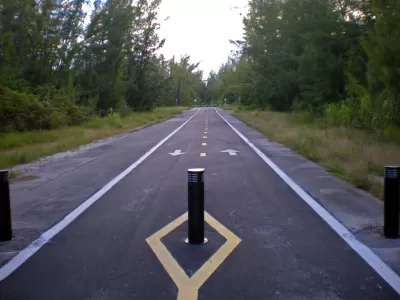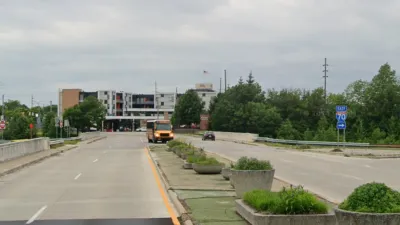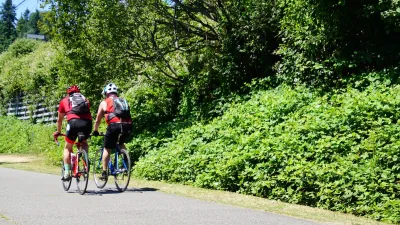While a federally-funded network of bike paths is in the works elsewhere in the city, the Major Taylor Trail gets little use from Chicago residents. The main problems are a lack of awareness and the South Side's fearsome reputation.

Many Chicago bike enthusiasts frequent the 606, a popular path following an old railroad bed on the Northwest Side. But to the south, the Major Taylor Trail gets little love, though it was built eight years earlier. Mary Wisniewski discusses why that is.
In many respects, Chicagoan cyclists enjoy a widening array of options. One of them is the Cal-Sag trail and the adjacent 86-mile Southland Century bike loop. "The Major Taylor will link to the popular Cal-Sag Trail, being built with $21 million of mostly federal funds. [...] If all goes as planned, in 2018 the Cal-Sag will be the northern leg of a mostly off-road loop that will include the Old Plank Road, Thorn Creek, Centennial and I&M Canal trails and the Burnham and Pennsy greenways."
The biggest drawback for the Major Taylor is crime, or the perception of it. Snaking through low-slung less well-off suburbs of color, the Major Taylor Trail feels deserted. "The trail's solitude adds to the feeling of insecurity: The southern end leading to the Little Calumet River is lovely but on a quiet weekday feels like Fangorn Forest in 'The Lord of the Rings' — vaguely unsettling."
More users means a safer trail, but users won't show up until they think the trail's safe. A catch-22. Meanwhile, "Supporters keep publicizing the trail through the bike community, social media and holding group events to get more people to try it."
FULL STORY: Why the Major Taylor isn't as well-known — or used — as The 606

Planetizen Federal Action Tracker
A weekly monitor of how Trump’s orders and actions are impacting planners and planning in America.

Congressman Proposes Bill to Rename DC Metro “Trump Train”
The Make Autorail Great Again Act would withhold federal funding to the system until the Washington Metropolitan Area Transit Authority (WMATA), rebrands as the Washington Metropolitan Authority for Greater Access (WMAGA).

The Simple Legislative Tool Transforming Vacant Downtowns
In California, Michigan and Georgia, an easy win is bringing dollars — and delight — back to city centers.

The States Losing Rural Delivery Rooms at an Alarming Pace
In some states, as few as 9% of rural hospitals still deliver babies. As a result, rising pre-term births, no adequate pre-term care and "harrowing" close calls are a growing reality.

The Small South Asian Republic Going all in on EVs
Thanks to one simple policy change less than five years ago, 65% of new cars in this Himalayan country are now electric.

DC Backpedals on Bike Lane Protection, Swaps Barriers for Paint
Citing aesthetic concerns, the city is removing the concrete barriers and flexposts that once separated Arizona Avenue cyclists from motor vehicles.
Urban Design for Planners 1: Software Tools
This six-course series explores essential urban design concepts using open source software and equips planners with the tools they need to participate fully in the urban design process.
Planning for Universal Design
Learn the tools for implementing Universal Design in planning regulations.
Smith Gee Studio
City of Charlotte
City of Camden Redevelopment Agency
City of Astoria
Transportation Research & Education Center (TREC) at Portland State University
US High Speed Rail Association
City of Camden Redevelopment Agency
Municipality of Princeton (NJ)





























